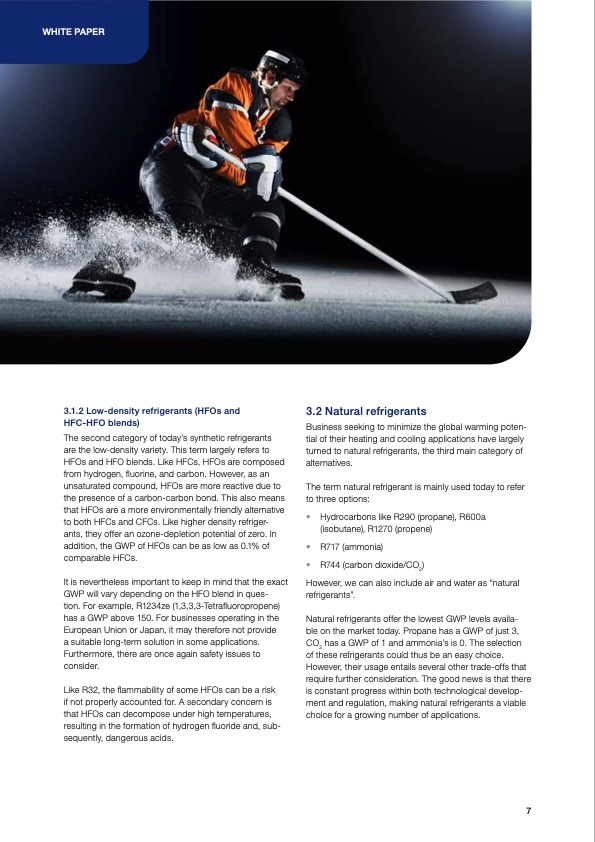
PDF Publication Title:
Text from PDF Page: 007
WHITE PAPER 3.1.2 Low-density refrigerants (HFOs and HFC-HFO blends) The second category of today’s synthetic refrigerants are the low-density variety. This term largely refers to HFOs and HFO blends. Like HFCs, HFOs are composed from hydrogen, fluorine, and carbon. However, as an unsaturated compound, HFOs are more reactive due to the presence of a carbon-carbon bond. This also means that HFOs are a more environmentally friendly alternative to both HFCs and CFCs. Like higher density refriger- ants, they offer an ozone-depletion potential of zero. In addition, the GWP of HFOs can be as low as 0.1% of comparable HFCs. It is nevertheless important to keep in mind that the exact GWP will vary depending on the HFO blend in ques- tion. For example, R1234ze (1,3,3,3-Tetrafluoropropene) has a GWP above 150. For businesses operating in the European Union or Japan, it may therefore not provide a suitable long-term solution in some applications. Furthermore, there are once again safety issues to consider. Like R32, the flammability of some HFOs can be a risk if not properly accounted for. A secondary concern is that HFOs can decompose under high temperatures, resulting in the formation of hydrogen fluoride and, sub- sequently, dangerous acids. 3.2 Natural refrigerants Business seeking to minimize the global warming poten- tial of their heating and cooling applications have largely turned to natural refrigerants, the third main category of alternatives. The term natural refrigerant is mainly used today to refer to three options: • Hydrocarbons like R290 (propane), R600a (isobutane), R1270 (propene) • R717 (ammonia) • R744 (carbon dioxide/CO2) However, we can also include air and water as “natural refrigerants”. Natural refrigerants offer the lowest GWP levels availa- ble on the market today. Propane has a GWP of just 3, CO2 has a GWP of 1 and ammonia’s is 0. The selection of these refrigerants could thus be an easy choice. However, their usage entails several other trade-offs that require further consideration. The good news is that there is constant progress within both technological develop- ment and regulation, making natural refrigerants a viable choice for a growing number of applications. 7PDF Image | guide for selecting and accommodating refrigerants

PDF Search Title:
guide for selecting and accommodating refrigerantsOriginal File Name Searched:
refrigerants-market_white_paper_en.pdfDIY PDF Search: Google It | Yahoo | Bing
CO2 Organic Rankine Cycle Experimenter Platform The supercritical CO2 phase change system is both a heat pump and organic rankine cycle which can be used for those purposes and as a supercritical extractor for advanced subcritical and supercritical extraction technology. Uses include producing nanoparticles, precious metal CO2 extraction, lithium battery recycling, and other applications... More Info
Heat Pumps CO2 ORC Heat Pump System Platform More Info
| CONTACT TEL: 608-238-6001 Email: greg@infinityturbine.com | RSS | AMP |